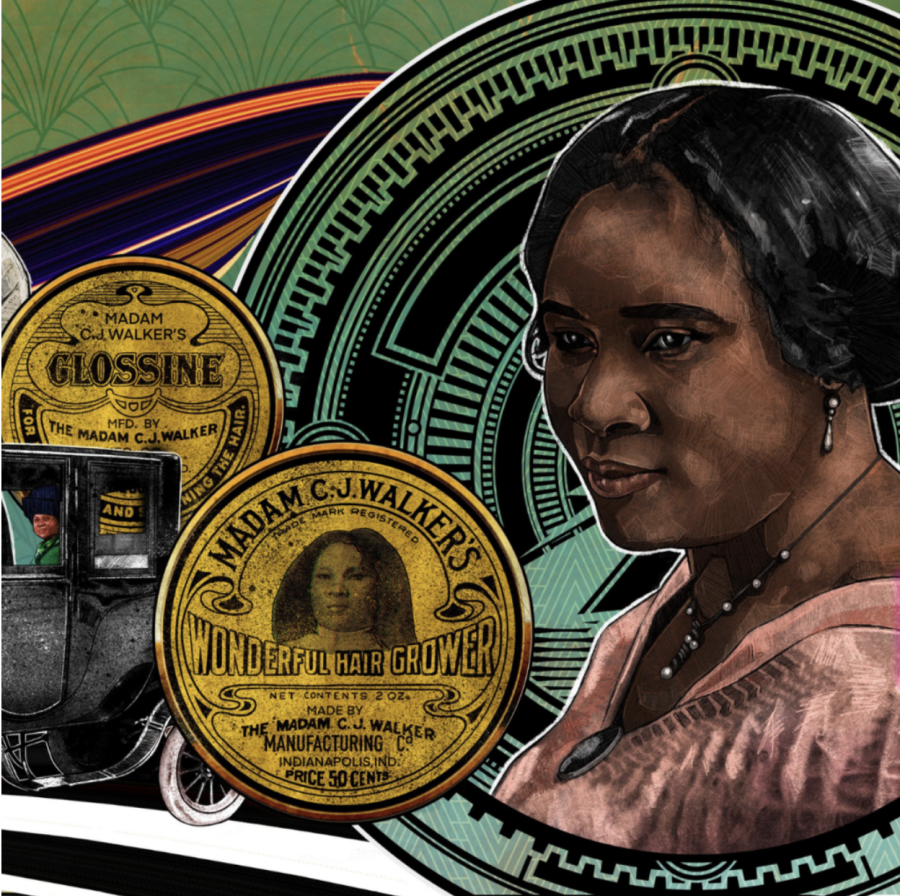How Madam C.J. Walker Built Her Empire
Image above is a mural that was inside the Indy Airport, created by the collaboration of the Madam Walker Legacy center and artist Tasha Beckwith.
March 4, 2022
The Beginning
Madam C.J. Walker was an orphan, a laundress, a laborer, but more than all of that she was a philanthropist, an entrepreneur and the first black woman millionaire in the U.S. She was often quoted saying “I got myself a start by giving myself a start.”, Orphaned by her sharecropping parents at the age of seven, this statement rang true. She worked with her sister in the cotton fields and at the age of fourteen, she married Moses McWilliams, to escape her abusive brother-in-law. When her husband died soon after their marriage in 1887, she was left alone to raise her two-year-old daughter Lelia. To provide for the two of them, she moved to St. Louis, Missouri where she worked as a cook while balancing night school.
The Empire
Madam Walker moved to St. Louis to be with her four brothers, and after facing the stress of school and labor, she began to suffer hair loss. Her brothers were all barbers, but even between them and the other hair care products on the market, there seemed to be no remedy. So she began experimenting with at-home solutions, and after a career change and a marriage to Charles Joseph Walker, she created her own product. Madam C.J. Walker’s Wonderful Hair Grower, a healing and scalp nourishment formula, which allegedly appeared to Mme. Walker in a dream (womenshistory.org). Walker traveled for a year and a half on a campaign crusade promoting her concoctions door to door and performing demonstrations in churches. She marketed specifically to black women and won loyal customers through a personal approach, which advertised the health benefits of her products.
The Expansion
Finally, it was time to mass-produce Madam Walker’s famous formula. She opened a beauty school and factory in Pittsburgh in 1908, but quickly moved her headquarters to Indianapolis in 1910. Indianapolis was an ideal location, with its access to railroads for distribution and its large pool of black customers. She employed 3,000 people, mostly black women, who sold her products door to door. In 1917, She also started the National Negro Cosmetics Manufacturers Association to help support other black businesses in the cosmetics industry (madamcjwalker.com). Business was booming for Walker and sales were upwards of $500,000 in the last year of her life.
The Legacy
Madam Walker’s rags to riches story continues to inspire many, as she never let anything stop her from success. She used her immense wealth to contribute to many causes. She covered the tuition of six African American students at the Tuskegee Institute, donated $5,000 to the NAACP’s efforts and allocated two-thirds of the company’s future profits to charity in her will (history.com). She also was integral to the Harlem Renaissance, where her Manhattan home became a meeting place for many members. Madam C.J. Walker died at the age of 51 due to hypertension, in her estate in New York. Her legacy lives on as she is remembered as an innovative, philanthropic millionaire who paved the way for future black female entrepreneurs.
































